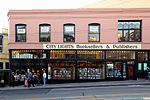Ma-Tsu Temple (San Francisco, California)

The Ma-Tsu Temple is a Taoist temple in San Francisco's Chinatown. Founded in 1986, it is dedicated to Mazu and has foundational ties to the Chaotian Temple in Beigang, Yunlin, Taiwan.Its founding has been described as reflective of both a change in Chinese American demographics following the Immigration and Nationality Act of 1965 and the rise of a transnational Taiwanese-American community economically enabled by the Taiwan Miracle of the 1980s.The temple was originally located on Grant Avenue before moving to its present location on Becket Street in 1996. It is not to be confused with the Tin How Temple two blocks to the south, which is likewise dedicated to Mazu (carrying one of her popular names in Cantonese), but was founded in 1910 and is the oldest extant Taoist temple in Chinatown.
Excerpt from the Wikipedia article Ma-Tsu Temple (San Francisco, California) (License: CC BY-SA 3.0, Authors, Images).Ma-Tsu Temple (San Francisco, California)
Beckett Street, San Francisco
Geographical coordinates (GPS) Address Website External links Nearby Places Show on map
Geographical coordinates (GPS)
| Latitude | Longitude |
|---|---|
| N 37.7965 ° | E -122.4064 ° |
Address
Ma-Tsu Temple
Beckett Street 30
94133 San Francisco
California, United States
Open on Google Maps









